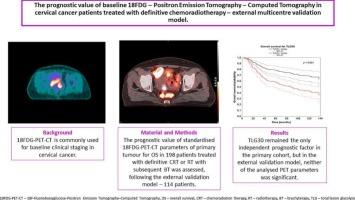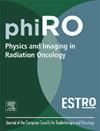The prognostic value of baseline 18FDG – Positron Emission Tomography – Computed Tomography in cervical cancer patients treated with definitive chemoradiotherapy – External multicentre validation model
IF 3.3
Q2 ONCOLOGY
引用次数: 0
Abstract
Background and purpose
18F-Fluorodeoxyglucose-Positron Emission Tomography – Computed Tomography (18FDG-PET-CT) is commonly used for baseline clinical staging in cervical cancer. In this study, we assessed the prognostic value of standardised PET-CT parameters for the overall survival (OS) of patients treated with definitive chemoradiotherapy (CRT), or radiotherapy (RT) with subsequent brachytherapy (BT).
Material and methods
This study included consecutive cervical cancer patients treated with definitive CRT or RT and BT, between 2011 and 2017, at a single tertiary institution. Each patient had a 18-FDG-PET-CT scan before treatment. Patients from three institutions with equal inclusion criteria were included in external validation group. The metabolic parameters of the primary tumour: standardized uptake value (SUV) derivatives, metabolic tumour volume (MTV) and total lesion glycolysis (TLG), were evaluated using the semi-automated method. Statistical analysis was conducted using the Kaplan–Meier method, log-rank tests, Cox regression models, and the Akaike Information Criterion (AIC).
Results
The study group included 198 patients treated with RT (100 %) concurrent with Cisplatin-based CT (91.4 %), and subsequent BT (99 %). The majority of patients were diagnosed with squamous cell carcinoma (96.5 %) and International Federation of Gynaecology and Obstetrics (FIGO) stage III disease (84.3 %). The OS was significantly higher in patients with TLG30 below the median value (78.8 % vs. 58.9 %; p < 0.01). TLG30 remained as the only independent prognostic factor (hazard ratio 1.32,95 % confidence interval:1.12–1.56, p < 0.01). In the external validation model neither of analysed PET parameters were significant.
Conclusions
A high TLG30 was associated with worse OS in primary cohort. However, external validation model did not confirm the clinical utility of the cervical tumour’s metabolic parameters.

基线18FDG -正电子发射断层扫描-计算机断层扫描在宫颈癌晚期放化疗患者中的预后价值-外部多中心验证模型
背景和目的18f -氟脱氧葡萄糖-正电子发射断层扫描-计算机断层扫描(18FDG-PET-CT)通常用于宫颈癌的基线临床分期。在这项研究中,我们评估了标准化PET-CT参数对接受终期放化疗(CRT)或放疗(RT)和随后的近距离放疗(BT)治疗的患者总生存期(OS)的预后价值。材料和方法本研究包括2011年至2017年在一所高等教育机构连续接受明确CRT或RT和BT治疗的宫颈癌患者。每位患者在治疗前都进行了18-FDG-PET-CT扫描。来自三个机构的患者具有相同的纳入标准,被纳入外部验证组。采用半自动化方法评估原发肿瘤的代谢参数:标准化摄取值(SUV)衍生物、代谢肿瘤体积(MTV)和病变总糖酵解(TLG)。采用Kaplan-Meier法、log-rank检验、Cox回归模型和赤池信息准则(Akaike Information Criterion, AIC)进行统计分析。结果研究组包括198例接受RT(100%)联合顺铂基CT(91.4%)和后续BT(99%)治疗的患者。大多数患者被诊断为鳞状细胞癌(96.5%)和国际妇产联合会(FIGO) III期疾病(84.3%)。TLG30低于中位值的患者OS明显更高(78.8%比58.9%;p < 0.01)。TLG30仍然是唯一的独立预后因素(风险比1.32,95%可信区间:1.12-1.56,p < 0.01)。在外部验证模型中,所分析的PET参数均不显著。结论TLG30水平高与原发性患者OS恶化相关。然而,外部验证模型并未证实宫颈肿瘤代谢参数的临床实用性。
本文章由计算机程序翻译,如有差异,请以英文原文为准。
求助全文
约1分钟内获得全文
求助全文
来源期刊

Physics and Imaging in Radiation Oncology
Physics and Astronomy-Radiation
CiteScore
5.30
自引率
18.90%
发文量
93
审稿时长
6 weeks
 求助内容:
求助内容: 应助结果提醒方式:
应助结果提醒方式:


